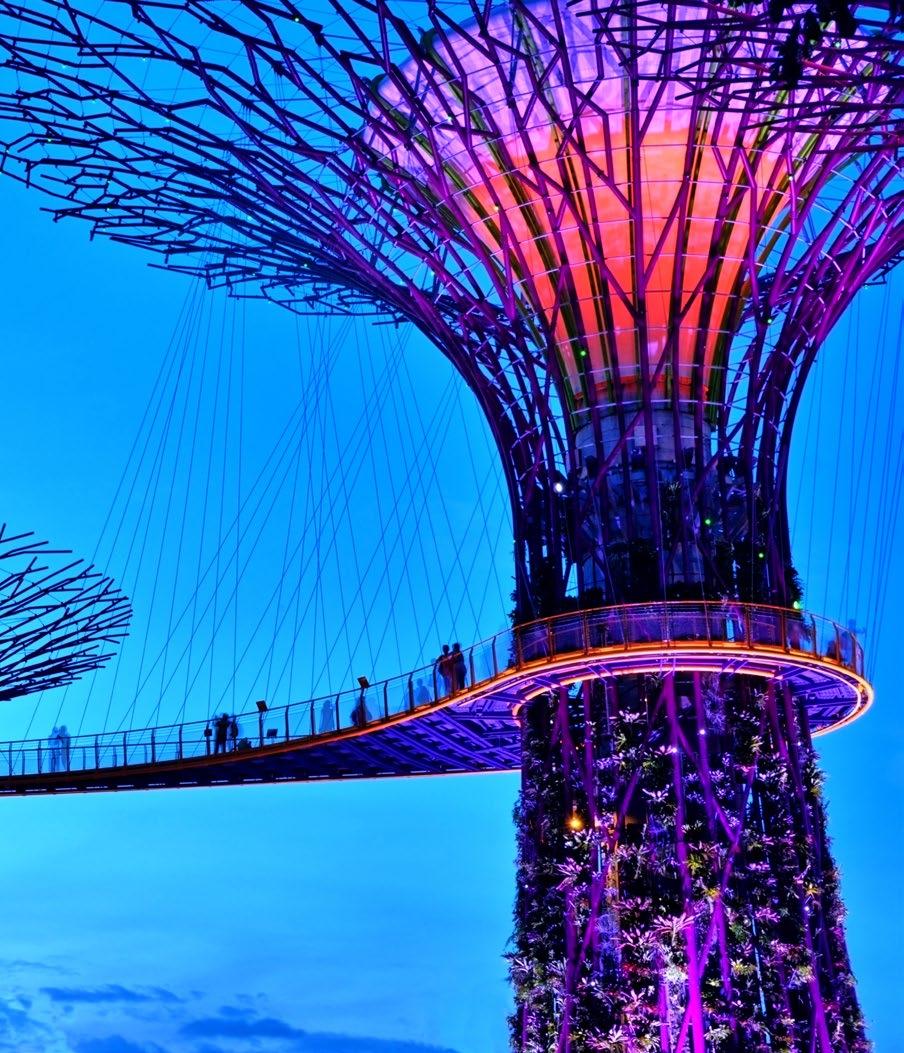
20 minute read
BORDEAUX
Legendary Land
Explore the historic châteaux and fine wines of Bordeaux.
Advertisement
BY KATIE MCELVEEN
Span of Time:
Pont de Pierre (above), and (opposite page, left to right) Gross Cloche; and the interior of La Cité du Vin, a museum presenting the history of wine and also wine bottles
PHOTOS: © LEONID ANDRONOV | DREAMSTIME.COM, © ANIBAL TREJO | DREAMSTIME.COM, © SUSE SCHULZ | DREAMSTIME .COM I t’s been more than 20 years since the city of Bordeaux shook off centuries of neglect and scrubbed the soot from its buildings, cleared the crumbling warehouses from its riverfront and reconfigured streets to make them more pedestrian-friendly.
The results have been startling. Hidden for decades behind a dilapidated wharf, the Garonne River sparkles beyond a sweeping promenade that runs from the lively Chartrons district, where outdoor cafés give way to elegant antique shops along Rue Notre Dame, to Pont de Pierre, the graceful 19th-century bridge commissioned by Napoleon. There are parks, gardens, sculptures and fountains, too, most notably Le Miroir d’Eau, a massive black granite reflecting pool where splashing about has become a warm-weather ritual.
Step away from the river and you’ll find centuries-old churches with soaring spires; the hefty towers of medieval Gross Cloche; and the 18thcentury Neoclassical Grand Théatre, rimmed with a dozen sculptures of Greek and Roman gods. In all, more than 350 structures set within UNESCO’s largest urban complex are listed as historic monuments.
Then there’s the wine. Bordeaux’s dominance in the production and distribution of wine has its roots in the discovery, in the first century, of a grape variety that could withstand cold winters. It flourished in Bordeaux and — voilà — the modern wine industry was born. Well, not exactly. Centuries of refining methods of growing, harvesting, blending, aging and distributing wine came into play as well, but the end of the story remains the same: Bordeaux’s wines rate among the best in the world.
Oenophiles interested in learning even more about wine now have a place to do it: La Cité du Vin, opened in 2016 and the world’s largest museum devoted to wine (temporarily closed during the pandemic). Set within a massive golden carafe overlooking the river, the museum’s 10 levels of interactive exhibits detail the history, lore, tradition and art of wine. And it’s not just intellectual: Admission includes a trip to the Belvedère, the museum’s eighth-floor, glass-walled aerie, where free flights of wine from around the world are poured by friendly staffers eager to help visitors taste the difference between, say, Cabernet Sauvi-


LODGING
Hôtel de Pavie This former convent is now an elegant, 17-room Relais & Châteaux hotel with a 2-Michelin-starred restaurant. Guests can stay in town or at the nearby vineyard inn.
5 Place du Clocher, Saint-Émilion $$$$
Hôtel le Palais Gallien Located in a 19th-century private home just steps from an ancient amphitheater, this recently opened hotel features bold interiors and a lovely courtyard with an outdoor pool.
144 Rue Abbé de l’Épée, Bordeaux $$$$
InterContinental Bordeaux – Le Grand Hôtel It’s all about drama at this 130-room property, from the hip rooftop bar and flowerfilled courtyard to the blackgranite spa pool surrounded by two-story red pillars.
2-5 Place de la Comédie, Bordeaux $$$
DINING
Garopapilles Love surprises? You’ll adore this tiny, unpretentious Michelinstarred restaurant which serves a single menu each evening. The wine list is filled with treasures, but go for the always-inspired pairings.
62 Rue Abbé de l’Épée, Bordeaux $$$$$
La Grande Maison de Bernard Magrez Star chef Pierre Gagnaire oversees the kitchen at the 2-Michelin-starred La Grande Maison, set within a 19thcentury manse owned by wine magnate Bernard Magrez.
10 Rue Labottière, Bordeaux $$$$$
Racines Chef Daniel Gallacher may be self-taught, but his stylish, well-balanced dishes reflect his time in the kitchen with Alain Ducasse. Select from an extensive collection of wines by the glass, too.
59 Rue Georges Bonnac, Bordeaux $$$

Fertile Acres:
Vineyards of Saint-Émilion
PHOTO: © FREEPROD | DREAMSTIME.COM
INFO TO GO
Located about six miles from the city, Bordeaux-Mérignac Airport offers a full schedule of domestic and international flights. In addition to taxis and city buses, a shuttle runs directly to the train station. Highspeed train service from Paris’ Montparnasse station takes just a little more than two hours; traditional trains make the trip in about 3.5. gnons from various wine-producing regions around the globe.
For a city surrounded by vineyards that produce some of the most prestigious wines in the world, Bordeaux’s wine bars are refreshingly attitude-free. Set along a cobbled street in the lively Saint-Pierre neighborhood, Vins Urbains offers more than 250 varieties; you can buy a wonderful glass of wine for as little as €4 (about $4.85). Owners Jan and Christelle Bussiere are passionate about their vast collections and delighted to create impromptu flights. At The Wine Bar, tucked into Le Boutique Hôtel, sommelier Mike Germon holds blind tastings each evening at 5 p.m.; the €35 (about $43) price includes cheese and charcuterie. Bordeaux’s top wines, called “classified growths,” are rarely available by the glass; Bordeaux Wine Gallery is an exception, offering several classified wines for tasting. The system isn’t romantic — guests must insert a credit card into a sealed system which then dispenses the wine into the glass — but it provides a rare opportunity to try some of the region’s most legendary wines.
Even the most austere Bordeaux wines seem less intimidating within the relaxed, art-filled setting of the Bar à Vin, a tasting room run by the Bordeaux Wine Council. Take your pick of more than 30 wines by the glass, and don’t be afraid to ask for advice: Bar à Vin’s English-speaking staff is patient and well-informed. Tasters looking to deepen their knowledge can even enroll in an on-site wine school.
Once you’ve found your favorites, head around the corner to L’Intendant, a wine shop that stocks only the wines of Bordeaux — including the less expensive second and third wines of esteemed châteaux — among its 15,000 or so bottles. Ascending the steep spiral staircase that dominates the shop’s interior tests both pocketbooks and legs: With every turn, prices rise significantly.
Wineries in locales such as Napa, Sonoma and Chile have always welcomed visitors, but that hasn’t always been the case in Bordeaux. Fortunately, that tradition is changing, and in recent years many of the region’s historic estates opened their doors and cellars to guests. One, Château Beychevelle, has produced Cabernet-based wine in the Médoc village of Saint-Julien since 1565. At the imposing château filled with antiques and surrounded by formal gardens, a recent renovation added a strikingly contemporary cellar. In addition to private lunches and dinners and custom tastings, the château offers 12 guestrooms for overnight stays.
Château La Dominique, a Saint-Émilion-area château, offers innovative programs like blind tastings and an introductory tour for children. The 17th-century estate’s renowned Jean Nouvelle-designed restaurant features a second-story terrace composed of smooth, garnet-colored glass pebbles.
Located about 45 minutes northeast of Bordeaux, Saint-Émilion merits a visit on its own. Named for the Breton monk who settled in the region in the eighth century, the walled village presents a glorious tangle of hilly streets lined with wine shops (the Merlot-based wines crafted here are exceptional), restaurants and historic buildings. Several significant churches remain, including the Collegiate Church with its massive stained-glass windows and soaring Gothic arches. The Monolithic Church, carved from limestone, features a massive bell tower. With that exception, the church, with its quiet hermitage and catacombs, lies completely underground. Grab a glass of wine at one of the bustling outdoor cafés that fill the courtyard surrounding the church, or climb the stairs to Hôtel de Pavie, where a pretty patio overlooks the city’s atmospheric rooftops and, in the distance, acres of neat vineyards.
GT DIGITAL
Global Traveler offers diverse digital tools to help you stay connected on the go.
fine vines
Torrontés Tango



Argentina’s signature white will have all your senses dancing.
in an attempt to describe Torrontés, argentina’s signature white wine, some have compared it to Pinot Grigio, viognier, even Riesling. but none come close. Made from the grape of the same name, Torrontés is like no other. it begins with an aroma that conjures up a bouquet of flowers (the honeyed, perfumed Muscat of alexandria is one of its ancestors), hinting that a sweet wine will follow. but no, Torrontés goes toward dry and fruity with a tangy and spicy edge. it is the perfect aperitif and equally right with shellfish, niçoise salad, chicken, other whitemeat dishes, lightly flavored cheese and many asian foods. as americans discover this intriguing wine, they will also discover that, with a myriad of choices, even the most attractive Torrontés usually costs under $20. and what are the most attractive Torrontés? among two dozen that i’ve recently tasted, these are my favorites. Xavier Flouret Flaca 2008 ($18) is one of the most elegant Torrontés, with a delicate floral nose that hints of apricot and peach; a dry, round, well-structured body; a fruit-filled taste Powered by and vibrant acidity; and a long, delicious finish. its Muscat ancestor comes to the fore in lo Tengo 2009’s ($11.50) vivid, flowery aroma. it goes on to be a clearly focused, intensely flavored, bright and satisfying wine. There is a suggestion of sweet mint and an evocation of orange and peach in Finca la linda 2009’s ($11) aroma, followed by a relatively full body and excellent balance. altogether a pleasing, inviting wine. Finca el origen Reserva 2009 ($12) is clean, crisp and refreshing, offering a typical Torrontés floral flavor with pear and peach overtones and a gentle reminder of citrus fruits in the mouth. a particularly harmonious wine. The delightful Pascual Toso 2009 ($15) combines keen fruit flavors, herbal notes and a fresh lemony acidity with a trace of honey and floral tones. Following its aroma of fresh flowers and ripe fruit, Colomé 2009 ($15) is a graceful wine with citric notes reminiscent of grapefruit. The pale-shaded Dominio del Plata’s Crios 2009 ($13.50) has a lilac-scented aroma with peach overtones followed by a dry, tangy taste.
www.globaltravelerusa.com May 2011 | GLOBAL TRAVELER | 35
Globility
PLUS TRAVEL WITH APP-TITUDE globaltravelerusa.com | $4.99 November 2020
www.globaltravelerusa.com | $3.50 May 2011
THE SOURCE FOR LUxURY BUSINESS TRAVELERS
ABU DHABI
A HALF-CENTURY OF
BUILDING CASTLES
IN THE SANDANCHORAGE p. 68 AUSTIN p. 58 HANGZHOUCOLORADO SPRINGS p. 62 IMMORTALIZED BY EATING ACROSS AMERICA p. 70 PAINTERS AND NASHVILLE p. 48 POETS ALIKE SAN MIGUEL DE ALLENDE p. 61 SEATTLE p. 54 TEL AVIV FAMILY BUSINESS SKI DESTINATIONS p. 64 TORONTO p. 56 UNDISCOVERED U.S. BEACHES p. 72
MEETS ROMANCE
IN THE WHITE CITY
ICELAND ADVENTURE AWAITS IN THE LAND OF FIRE AND ICE THE NORTH AMERICA ISSUE
WINE & SPIRITS
Savor the Flavor
Straight or mixed, enjoy the unique spirit of Svedka vodka. BY EUNICE FRIED
Svedka is a Swedish vodka whose quality outpaces its price. First made by Guillaume Cuvelier in Lidköping, Sweden, in 1998, it arrived in the United States in 2007 through its American owner, Constellation Brands, and has since become the vodka of choice for many American drinkers. Taken by its winning combination of taste and cost, they made it one of the top-selling vodka brands in the United States.
While Svedka is only 22 years old, Sweden remains one of three countries considered the world’s oldest vodka makers, along with Poland and Russia. Svedka is made of Swedish winter wheat — four pounds needed for every bottle — and distilled five times. Like most vodkas, it is bottled straight as well as in a number of fruit forms. Among them are lemon, cherry, strawberry and peach. Straight Svedka contains 40 percent alcohol, while its flavored variations have 35 percent. And while some brands of vodka cost as much as $40–45 for a 750 ml bottle, Svedka ranges $15–20.
How best to enjoy Svedka? By itself and in as many additions and variations as your imagination allows.
To understand it in its natural state, begin with a small taste of Svedka straight. Chill a bottle in the freezer for a couple of hours or more. (It won’t freeze; it has too much alcohol to do that.) Pour a small amount in a chilled glass. Sip, slowly — very slowly — savoring each taste. The purpose is not to get drunk but to consider its flavors and enjoy every drop.
For mixing, the possibilities are virtually endless. Pour equal parts of a flavored Svedka and water or soda in a chilled glass and mix well. Garnish with citrus peels. Or combine 1 ounce each of Svedka vodka and rosé Svedka; 2 ounces grapefruit juice; and ½ ounce each of vanilla syrup, lemon juice and hibiscus tea. Shake and strain into a Collins glass filled with ice.
Perhaps, best of all, create your own Svedka original. Skål!
To Your Taste:
Svedka Vodka, Rosé and Strawberry Guava. Try a Tropical Cooler with 2 parts Svedka Strawberry Guava, 2 parts soda and garnish with fresh sliced strawberries.
PHOTOS: © SVEDKA VODKA, © MAKIDOTVN - DREAMSTIME.COM
26 globaltravelerusa.com JULY/AUGUST 2020
GLOBALTRAVELERUSA.COM GT APP
The new GT app isVisit the Global Traveler website to access daily content, our library of articles, reports, guides, deals and videos, and to subscribe to our newsletter offerings. Read GT on your iPhone and iPad. The GT app makes it easy to peruse the current issue, search the archives, bookmark favorites and more.
now available
Wi t h t h e n e w GT a p p , y o u w i l l b e a b l e t o r e a d Global Traveler a n y w h e r e y o u r b u s i n e s s t a k e s y o u , r i g h t o n y o u r i P h o n e o r i Pa d . GT NEWSLETTERS Av a i l a b l e f o r d o w n l o a d a t t h e A p p S t o r e
Global Traveler’s weekly newsletters keep you up to date with info on the go. Sign up for newsletters at global travelerusa.com/newsletter.
eFlyer USA
Publisher’s Picks Global Traveler’s weekly newslet- GT ’s publisher, Francis X. ter brings news, deals and reviews Gallagher, delivers his current right to you every Wednesday. travel favorites in this monthly e-newsletter.
GT on the Go
Spread the word about your business and products via GT on the Go, a customized e-newsletter.
Premium eDeal
Highlight one special offer or promotion via delivery to GT e-subscribers. GT on the Road
Our weekly slideshow brings stunning photos and information on a range of topics with a current worldwide focus to subscribers every Saturday.
Authentic Amsterdam
The progressive city retains its allure for LGBTQ+ visitors. BY MARK CHESNUT
With its legendary reputation as a progressive, liberal city, Amsterdam has long been a favorite destination for LGBTQ+ travelers. And while the pandemic limited access for leisure and business travel alike, the allure of this European metropolis will surely mean a surge in arrivals as the world reopens.
Visitors will find much of the same allure as they return to Amsterdam. The most popular neighborhoods for LGBTQ+ travelers include Amstel, dotted with traditional Dutch pubs called “brown cafés,” and Kerkstraat, a street lined with LGBTQ+-friendly hotels as well as Club Church, among the many nightclubs waiting to announce plans to reopen.
For diverse culinary experiences and LGBTQ+ nightlife, head to Reguliersdwarsstraat, yet another hub. Visitors to this area can dine at Lunchroom Downtown, toast at the SOHO pub or dance the night away at Club NYX, which — like other venues —also awaits reopening at press time.
LGBTQ+ travelers shouldn’t miss the area around Zeedijk and Warmoesstraat, where the popular café The Queen’s Head hosts lively drag bingo events, and Café �t Mandje features original décor from the city’s first gay and lesbian bar, opened in 1927.
Thomas Carpenter, owner, Huckleberry Travel, a New York City-based travel agency, recommends a variety of other activities for LGBTQ+ visitors. “An LGBTQ+ walking tour through the city, which is arguably the gay capital of Europe, is a great way to learn about the history and culture of the LGBTQ+ community of the city and an opportunity to connect with a local guide who can really give you the insider perspective,” he said, also listing trips to the flower market, bike rides and tulip-time river cruises among his favorite pastimes in the city.
When it comes to accommodations, visitors will find an array of interesting options, ranging from the luxurious Sofitel Legend The Grand Amsterdam, a member of IGLTA, to the all-welcoming Amistad Hotel. “In Amsterdam, it’s not hard to find gay-friendly lodging,” Carpenter said, noting he also recommends houseboat stays.
For details about travel to Amsterdam, the I Amsterdam website features extensive listings and information for LGBTQ+ travelers.
Original:
Café ‘t Mandje
PHOTO: © ATOSAN | DREAMSTIME.COM

Inspiring Confidence
Pittsburgh’s airports strive to create a safe and welcoming environment. BY MARY MELNICK

Pittsburgh’s two airports, Allegheny County Airport (AGC) and Pittsburgh International Airport (PIT), work hard to provide a safe and modern environment for travelers.
Since 1931 Allegheny County Airport has advanced modern corporate and recreation travel. To this day it continues to provide convenient access to nearby universities, financial and corporate operations, research facilities and world-renowned medical centers.
The airport houses one of the nation’s premier aviation maintenance schools, air medical transport services, flight training operations and two fixed-based operators. It also hosts several corporate planes and numerous private aircraft.
AGC Authority has always been dedicated to the health, safety and security of its employees and travelers. While following the new regulations and procedures in place due to COVID-19, it goes even further by implementing the highest safety standards and practices in the airport industry — today and in the future.
Currently preparing for the return of travel, the airport is launching an authority-wide initiative, PIT Safe Travels. In accordance with the guidelines from the Centers for Disease Control and Prevention, the initiative improves health and safety measures already in place throughout the facilities. Hoping to increase confidence in air travel, it will enhance protocols that outline best practices for reducing the spread of germs.
Following a new federal mandate, both of Pittsburgh’s major airports currently require travelers to wear masks during TSA check-in and while waiting in the airport. Passengers who refuse to mask up will be denied entry. As of now, the mandate will remain in place until May 11.
Pittsburgh International Airport works to improve the quality of its terminals to best support its travelers. The Terminal Modernization Program, originally announced in September 2017, is a billion-dollar project to create a new, consolidated terminal that modernizes outdated former hub facilities, better serves passengers, evokes the essence of Pittsburgh and more.
Early site work was set to begin in April 2020 but was delayed due to COVID-19. Since then, the TMP team worked closely with key stakeholders and airlines to re-evaluate the project in light of new public health concerns.
The team hopes to get a move on with early work beginning this month, and it hopes to start building the foundation of the terminal in early June. If all goes well with the timeline, the new terminal will open by 2024.
Moving Forward:
Artist's rendering of the interior of the Landside Terminal planned for the Terminal Modernization Program at PIT (above), and Allegheny County Airport (left)
PHOTOS: © ALLEGHENY COUNTY AIRPORT AUTHORITY
ALLEGHENY COUNTY AIRPORT & PITTSBURGH INTERNATIONAL AIRPORT flypittsburgh.com

Fruitful Journeys
Be aware of risks when seeking reproductive treatments abroad. BY DEBRA BOKUR
For the millions of people who struggle to conceive, the medical travel niche of reproductive tourism remains a top reason to head abroad. According to a study published by The American Journal of Medicine, fertility treatments rank as one of the top eight reasons travelers seek medical treatment outside of the United States, accounting for roughly 1 million-plus Americans who cross borders in search of reproduction therapies.
The inability to conceive is a surprisingly common condition that affects an estimated 8 to 12 percent of people who actively attempt to become pregnant. That’s where assisted reproductive technologies, including artificial insemination and in vitro fertilization, can be useful options. The price for treatment abroad, including travel expenses, is often a fraction of what the same treatments cost within the United States.
Prospective travelers should, however, keep in mind rules governing fertility treatments vary from country to country and apply directly to travelers, regardless of their country of origin. In some places (though such treatments may be advertised as available), fertility treatments are frowned upon or prohibited by religious tenets, cultural attitudes or legal restrictions. Even where allowed, issues may include the destination’s legal definition of “family,” whether anonymity is guaranteed for donors of sperm and eggs, the length of the allowed in vitro development period for embryos, genetic screening, the maximum storage time for frozen embryos, and the maximum allowed number of embryos that can be transferred and implanted.
Popular destinations abroad for assisted reproductive technologies include Israel, Mexico, Denmark, Barbados, Turkey, India and Iran. Be certain to select a hospital certified to meet the highest standards of training, care and facilities. Respected certification entities include Joint Commission International, the International Organization for Standardization and the European Society of Human Reproduction and Embryology.
Some studies suggest that even though rates of successful IVF-assisted pregnancies are lower when originating in certain countries, including Turkey, the overall costs — even including travel — are so much lower, the risk is perceived as acceptable. As in many countries, the reproduction sector of the Turkish medical tourism market is actively supported by policy makers who recognize the financial benefit of a dependably large influx of medical tourists struggling with fertility challenges.
Regardless of the destination, fertility treatments are not without risks. These range from health complications, infections and pregnancy failure to multiple live births — a statistically common occurrence. When choosing a hospital or clinic, it’s important to be familiar with what emergency facilities are available, the existing screening policies in place for staff health, and the infection rates for hospital-acquired infections, including methicillin-resistant Staphylococcus aureus (known familiarly as MRSA) and C. difficile.


Singapore
People stroll along the Skyway at Gardens by the Bay, where the Supertrees come alive with a spectacular display of lights and sounds at night. Learn more when you read Destination One: Singapore in the April/May issue.
PHOTO: © HASLINDA | DREAMSTIME.COM






Live the French way
Sofitel Los Angeles at Beverly Hills 8555 Beverly Boulevard, 90048 Los Angeles Visit www.sofitel-los-angeles.com







